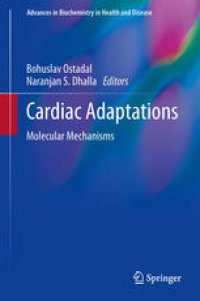
Ebook: Cardiac Adaptations: Molecular Mechanisms
- Tags: Medical Biochemistry, Molecular Medicine, Cardiology, Biochemistry general, Receptors, Human Physiology
- Series: Advances in Biochemistry in Health and Disease 4
- Year: 2013
- Publisher: Springer-Verlag New York
- Edition: 1
- Language: English
- pdf
This book summarizes present knowledge of different mechanisms involved in the development of positive and negative consequences of cardiac adaptation. Particular attention is paid to the still underestimated adaptive cardiac responses during development, to adaptation to the frequently occurring pressure and volume overload as well as to cardiac changes, induced by enduring exercise and chronic hypoxia. Cardiac Adaptations will be of great value to cardiovascular investigators, who will find this book highly useful in their cardiovascular studies for finding solutions in diverse pathological conditions; it will also appeal to students, fellows, scientists, and clinicians interested in cardiovascular abnormalities.
The processes of adaptation and maladaptation play an important role in the pathogeny of serious cardiovascular diseases, such as hypertension, valvular diseases, congenital heart disease, myocardial infarction and different cardiomyopathies as well as during adaptation to exercise and high altitude hypoxia. This volume incorporates the rapidly developing basic and clinically relevant information on adaptive mechanisms, thereby contributing to the better understanding of possible prevention and therapy of life-threatening cardiovascular diseases.
The first section of this volume focuses on developmental aspects of cardiac adaptation, including chapters on comparative and molecular aspects of cardiac development, prenatal and postnatal developments, coronary vascular development, and ontogenetic adaptation to hypoxia, as well as cardiac and arterial adaptation during aging. The second section is devoted to cardiac adaptations to overload on the heart, centered around the mechanisms of cardiac hypertrophy due to pressure overload, volume overload, exercise, gender difference, high altitude, and different pathological situations. The third section of this volume highlights the roles of sympathetic nervous system with respect to ?-adrenoceptor and ?-adrenoceptor mechanisms in the development of cardiac hypertrophy. Cardiac Adaptations will be of great value to cardiovascular investigators, who will find this book highly useful in their cardiovascular studies for finding solutions in diverse pathological conditions; it will also appeal to students, fellows, scientists, and clinicians interested in cardiovascular abnormalities.
The processes of adaptation and maladaptation play an important role in the pathogeny of serious cardiovascular diseases, such as hypertension, valvular diseases, congenital heart disease, myocardial infarction and different cardiomyopathies as well as during adaptation to exercise and high altitude hypoxia. This volume incorporates the rapidly developing basic and clinically relevant information on adaptive mechanisms, thereby contributing to the better understanding of possible prevention and therapy of life-threatening cardiovascular diseases.
The first section of this volume focuses on developmental aspects of cardiac adaptation, including chapters on comparative and molecular aspects of cardiac development, prenatal and postnatal developments, coronary vascular development, and ontogenetic adaptation to hypoxia, as well as cardiac and arterial adaptation during aging. The second section is devoted to cardiac adaptations to overload on the heart, centered around the mechanisms of cardiac hypertrophy due to pressure overload, volume overload, exercise, gender difference, high altitude, and different pathological situations. The third section of this volume highlights the roles of sympathetic nervous system with respect to ?-adrenoceptor and ?-adrenoceptor mechanisms in the development of cardiac hypertrophy. Cardiac Adaptations will be of great value to cardiovascular investigators, who will find this book highly useful in their cardiovascular studies for finding solutions in diverse pathological conditions; it will also appeal to students, fellows, scientists, and clinicians interested in cardiovascular abnormalities.
Content:
Front Matter....Pages i-xvii
Front Matter....Pages 1-1
Comparative Aspects of Cardiac Adaptation....Pages 3-18
Molecular Mechanisms of Cardiac Development....Pages 19-39
Prenatal Adaptations to Overload....Pages 41-57
Cardiac Metabolic Adaptation During Postnatal Development....Pages 59-77
Ontogenetic Aspects of Cardiac Adaptation to Chronic Hypoxia....Pages 79-98
Heart and Arterial Aging....Pages 99-110
Front Matter....Pages 111-144
Cardiac Adaptation to Volume Overload....Pages 145-145
Functional Adaptation During the Development of Cardiac Hypertrophy and Heart Failure in Females....Pages 147-166
Impact of Gender and Exercise on Cardiac Adaptation to Pathological Situations: Sex Hormones, Exercise and Cardiac Adaptation ....Pages 167-199
Cardiopulmonary Adaptation to High Altitude....Pages 201-212
Exercise Training and Adverse Cardiac Remodeling and Dysfunction in Mice....Pages 213-231
The Athlete’s Heart....Pages 233-249
Front Matter....Pages 251-267
Role of ?-Adrenoceptor/Adenylyl Cyclase System in Cardiac Hypertrophy....Pages 269-287
Cardiac Remodeling in the Hypertrophic Heart: Signal-Dependent Regulation of the Fibrotic Gene Program by CLP-1....Pages 289-302
Role of Sirtuins in Regulation of Cardiac Adaptation Associated with Hypertrophy....Pages 303-303
Adaptation of Cardiac and Skeletal Muscle Mitochondria to Endurance Training: Implications for Cardiac Protection....Pages 305-324
Front Matter....Pages 325-340
Adenosine as an Endogenous Adaptive Cardiac Antihypertrophic and Antiremodelling Factor....Pages 341-359
Myocardial Adaptation and Autophagy....Pages 361-374
Modulatory Role of VEGF in Angiogenesis for Cell Survival....Pages 375-402
The Role of CaM Kinase II in Cardiac Function in Health and Disease....Pages 303-303
Back Matter....Pages 403-414
....Pages 415-432